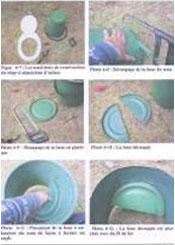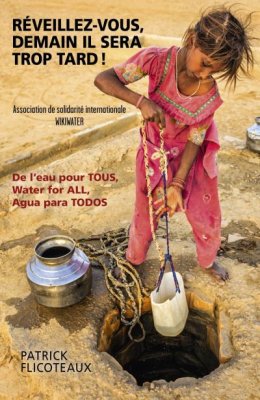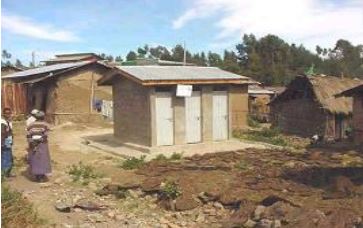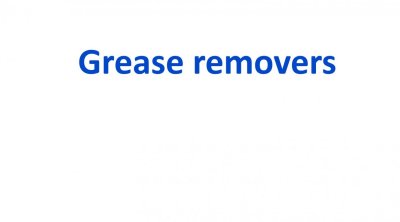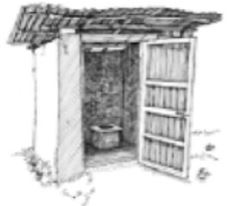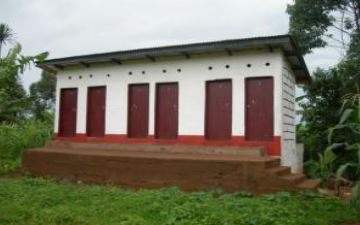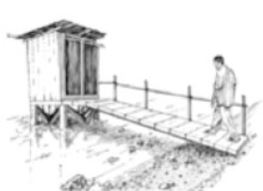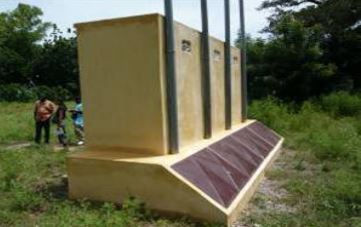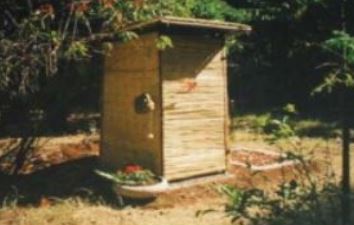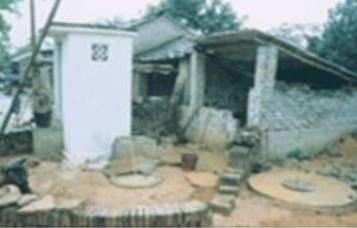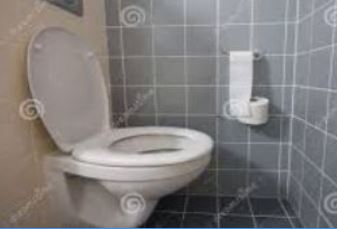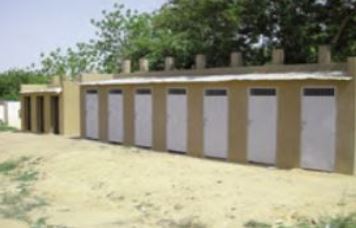1) What is involved ?
Dry type latrines, which thus work without water, the most ecological of which separate urine from faeces allowing waste to be recycled by turning them into compost (excreta) or liquid fertiliser (urine) which can be used to fertilise soil or crops. It is therefore an improved composting latrine (see fact sheet A9).
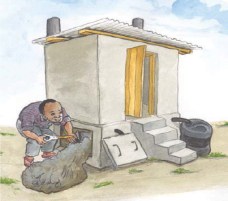
Illustration WEDC
2) Who chiefly uses this means and since when ?
This fairly recent type of latrine was introduced by research organizations such as CREPA in Burkina Faso or NGOs such as Toilettes du monde and is currently in widespread use and is one of the most recommended types.
3) Why ?
Because it is not complicated to make, it protects Nature and transforms waste into a source of income or savings, either through the sale of compost or by reducing the use of expensive, often imported fertilisers, thus saving foreign currency.
4) Why and how excreta be used as a resource ?
This has been explained for solid excrement which can be transformed into agricultural fertiliser through composting (see fact sheet A9 "Compost latrines").
Compost is a healthy, stabilised product, all pathogens having been destroyed, and the nutrients it contains can be directly assimilated by plants.
Urine is rich in phosphorus (of which it generally contains from 40 to 50%), potassium (from 50 to 60%) nitrogen (from 75 to 80%), which are substances which are particularly sought after by many plants and are often contained in commercial fertilisers.
The World Health Organization (WHO) considers that the urine of healthy individuals is virtually free of pathogens, and can normally be used as fertiliser after a month, but as it can be contaminated on exiting from the body or by coming into contact with faeces, it is best to consider it danger free after 6 months, a time which should be observed if it is used for crops other than family crops.
5) Who is primarily concerned ? Places or contexts in which this means appears to be the best suited
- These latrines are well suited to rural or suburban areas, but are now also used in towns. An Indian town, Musiri, even, according to the Times, took an original step to encourage the residents of certain insalubrious districts to use ECOCAN public toilets : instead of making them pay, it gives them a rupee every time they use them and reimburses itself by selling fertilisers...
- The best contexts will, however, be those where their introduction has been preceded by a major campaign to raise awareness of hygiene problems (see fact sheets C1 to C4 on the corresponding methods) and the often little known properties of the recovered material and the use of which may give rise to a reflexive reaction of revulsion and rejection.
- CREPA (Centre Régional pour l’Eau potable et l’Assainissement at lowest cost, Ouagadougou) calculated that Burkina Faso could save €72million a year if it could recycle the nutrients in the human excreta of the entire population, which while obviously not possible, gives an order of magnitude idea of the potential maximum savings.
6) What does this process involve ? How is it used ?
There are several standalone eco-sanitation techniques. Their variety should, when backed by awareness raising campaigns, usually make it possible to determine the one which would be most culturally and economically acceptable. It is often possible to find a good tradeoff between their cost, their maintenance method and the wishes of the community concerned. Indeed, while their price may seem high, it can be favourably compared to other latrines, and can be offset by savings or sale of compost and thus reduced, but with the drawback, however, of requiring more maintenance and handling.
a) The basic principle is as follows
It is a more advanced ecological variant of composting latrines (see Fact Sheet A9) and only differs in that it has a system for separating faeces and urine.
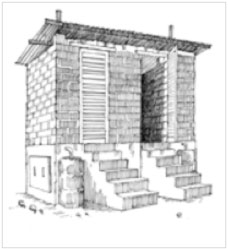
Illustration WEDC
As for other types of latrine (see Fact Sheet A5 "Latrines-General points") one or two pits are required but in this case above ground and with a smaller volume (filling time often less than a year), which accounts for their commonly being referred to as compartments, which makes it easier to empty them and avoids the pollution of ground water.
These pits are covered with a slab, usually made of concrete but sometimes of other cheaper local materials (see the same fact sheet).
The particularity of ECOSAN latrines is that this slab is specially designed to allow faeces and urine to be collected and evacuated separately below it.
The slab is topped by a superstructure, which again may be more or less sophisticated (see the same fact sheet) after providing a self-ventilation device, as in the case of VIP latrines (see Fact Sheet A8 "VIP latrines") and inserting a container containing, as with composting latrines, ash, shavings or soil to be added to excreta each time the latrine is used, with a reservoir placed outside for the collection of urine.
b) Making the seat or the urine separation slab
This can be done in a workshop using moulds. But it can just as well be done locally at low cost using simple local materials.
If, for more comfort, this separation is done with a seat, a simple plastic bucket can be used
- first by cutting the bottom out of the bucket and gluing half of it at the bucket mid-height, at an angle so as to form a urine receptacle, and making a hole in it with a with a hot iron and attaching an evacuation tube to it,
- by surrounding the bucket with wire before covering it with concrete to solidify it,
- by making a seat top or a lid and connecting the assembly to the pits and to the urine container.
But for squatting use of the latrine, this separation can be made directly on a slab with two larger holes, one of which is made over a bucket, with a volume of say 10 litres, made of reinforced plastic or concrete, mounted at an angle under the slab to recover the urine.
For this purpose, and for the construction of other items of the latrine, reference can be made to the excellent, extensively illustrated CREPA guide "Composting Latrines" indicated at the end of this fact sheet and pages 50 to 61 in particular (including the photo above on how to start to make a seat)
c) Some model variants
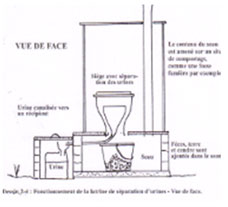
Lubricomposting with earthworms - Diagram by CREPA 
Most models include one or two pits/compartments and a self-ventilation system, but :
-some simpler models, which are mostly used in towns or by small families, are similar to biocontrolled composting latrines (see Fact Sheet A9) with the outer compartments being replaced by two inner buckets located under the latrine seat.
- other simpler compartment type models do not allow complete dehydration of faeces : they then have to undergo further treatment by suitable composting.
- finally, other, more elaborate, models have a third hole in the slab to allow anal cleaning after use, the water used for this purpose being collected into a specific container.

ECOSAN latrine models used in Nepal. Photo by WaterAid
d) Urine use
It is generally considered that :
- it is best to collect urine in plastic containers or jerry cans (since urine corrodes metal due to its high pH),
- not use more than 1.5 litres of urine should be used per m2 of crops per year to avoid hyper salinisation of the soil,
- urine should not be poured directly on plants or too near the roots (pour it into furrows instead), or done within a month of harvest time,
- urine should be diluted (at least one volume of urine for 3 to 4 litres of water).
- each year a person produces the amount of urine needed to fertilise an area of about 350 m2 (which is why these latrines are sometimes used less often on a family scale than on a community scale, as fertilising needs are lower).
7) Special difficulties and remedial action and/or precautions to be taken, if any
- Urine may be strongly contaminated by any contact with faeces. Particular care should thus be taken to make sure that users use these latrines properly and do not introduce urine through the holes in the slabs or seats reserved for faeces or vice versa.
- Hands should be washed after using the latrine or handling compost or urine.
- Most of these latrines do not allow anal cleansing. This can nevertheless be done using a receptacle containing crushed plants, sawdust or shavings. Some models, however, provide for this by collecting the corresponding small amount of water used in a small container.
8) Main advantages and drawbacks
a) Advantages
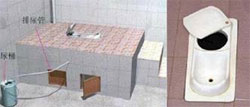
Indoor Ecosan latrine in China. Photo taken from EPFL Wikipedia
- urine and faeces can be recycled and used as fertiliser.
- very hygienic and environmentally friendly.
- cheaper, less smelly, faster to build, more sustainable and cost effective, while providing better protection of groundwater (pits above ground), than the VIP latrine, which is already a very good type of latrine.
- easy to maintain.
- reasonable investment cost which can be compensated by savings on fertiliser
- several types are available and several positions are possible (sitting, squatting)
b) Drawbacks
- Requires strong support for the principle by the population and appropriate prior training.
- Requires more frequent emptying (but easier, every 6 to 8 months (faeces) and 30 days (urine)) than other types.
- Risk of rejection for psychological reasons involving taboos or customs.
- There is a risk of urine piping being blocked by faeces.
- Generally does not allow anal cleaning (unless appropriate models are used).
- Ash, sawdust, shavings or dirt needs to be added after use.
Despite all its advantages, the ECOSAN latrine with urine separation may well not grow as fast as other types of latrines because of the high level of preparation and acceptance required on the part of populations, their frequent accessibility difficulties for the elderly and disabled, the fact that products are not as yet always used proficiently in fields and above all its initial investment cost which is still relatively high for low income families. It thus needs to be well suited to local conditions before being introduced.
9) Cost
The price varies quite significantly according to the model, the materials used and the country.
It works out at about €150 to 280 for one compartment and €250 to 400 for two compartments.
It is very close to the price of a VIP latrine (about €140 to 240 for a single pit and €180 to 300 for a double pit), and sometimes even lower, and not much more expensive than a composting latrine (€130 to 250 for one compartment)
10) Achievement examples
Many examples of the use of ECOSAN toilets can be found in the 29-page booklet, translated into French and well illustrated, entitled "Ecosan : concept and technologies" published by the German agency GTZ, and available at : http://www.netssaftutorial.com/file...
11) Where to obtain further information - Bibliography
a) Websites
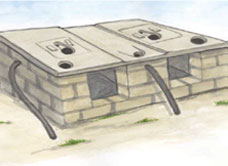
Illustration by WEDC
- PSEau : 117-page book published by CREPA (Peter Morgan) : "Composting latrines", an excellent, illustrated and handy book on various types of composting latrines, and how to make and use them. See pages 49 to 72 and 84 to 105 in particular. Document available, on line at : http://www.pseau.org/outils/biblio/...
- EAWAG (Swiss research institute located near Zurich) : "Compendium of sanitation systems and technologies", which is very comprehensive, illustrated and informative 158-page book, that can be downloaded as a complete document or chapter by chapter (6) and part of which is devoted to ECOSAN latrines.
Available in french and english at : http://www.eawag.ch/forschung/sande...
- Toilettes du monde : Illustrated summary fact sheet on the various types of ecological toilets :
Available, on line at : http://www.toilettesdumonde.org/_da...
-Water Aid and WEDC (Loughborough University) in the United Kingdom : "Low cost toilet options" : Catalogue, in English but also very well illustrated with drawings, of the existing types of low cost latrines, pits, slabs and superstructures, available at :
https://wedc-knowledge.lboro.ac.uk/...
- AKVO, a dynamic Dutch NGO, has posted on its website a very well documented and illustrated Wiki containing about fifty very concise fact sheets, in French and English, on about fifty topics related to sanitation, including ECOSAN latrines. Downloadable from : http://akvopedia.org/wiki/Urine_Div...
- Wikipedia – Ecole polytechnique de Lausanne : short brochure entitled "Three examples of ecological sanitation" in China, Yemen and Mexico.
Available, on line at : http://wiki.epfl.ch/copropolis/ivtroexe
b) Videos
- CREPA (Ouagadougou) : 8’ video entitled "Our urine is worth gold," explaining why and how :
Available, on line at : http://www.youtube.com/v/MdBJ6k377U...
- "Constructing an ECOSAN Toilet", which is an excellent animated video lasting 3’ published by UNICEF and explaining the principle of composting toilets and ECOSAN toilets with separation of urine and faeces, available at : http://www.youtube.com/watch?v=YV-1...
- "Ecosan toilet with bamboo superstructure" : 2’ video showing a low-cost Ecosan urine separation latrine with a built-in shower and a bamboo superstructure :
available at : http://www.youtube.com/watch?v=6xPq...
- "Ecosan toilet in Bengalore - towards sustainable sanitation" : Indian 5’ video explaining the operation of a fairly modern Ecosan toilet, available at : http://www.youtube.com/watch?v=SqpI...
- "Dry urine diversion toilet" : short, one-minute animated video showing how to use an Ecosan urine diversion toilet, http://www.youtube.com/watch?v=pYJE...
- "Biolatrines in the slums of Africa", a 3’ video showing, on the basis of AFD photos, the construction of a large Ecosan latrines in a slum : http://www.youtube.com/watch?NR=1&a...



